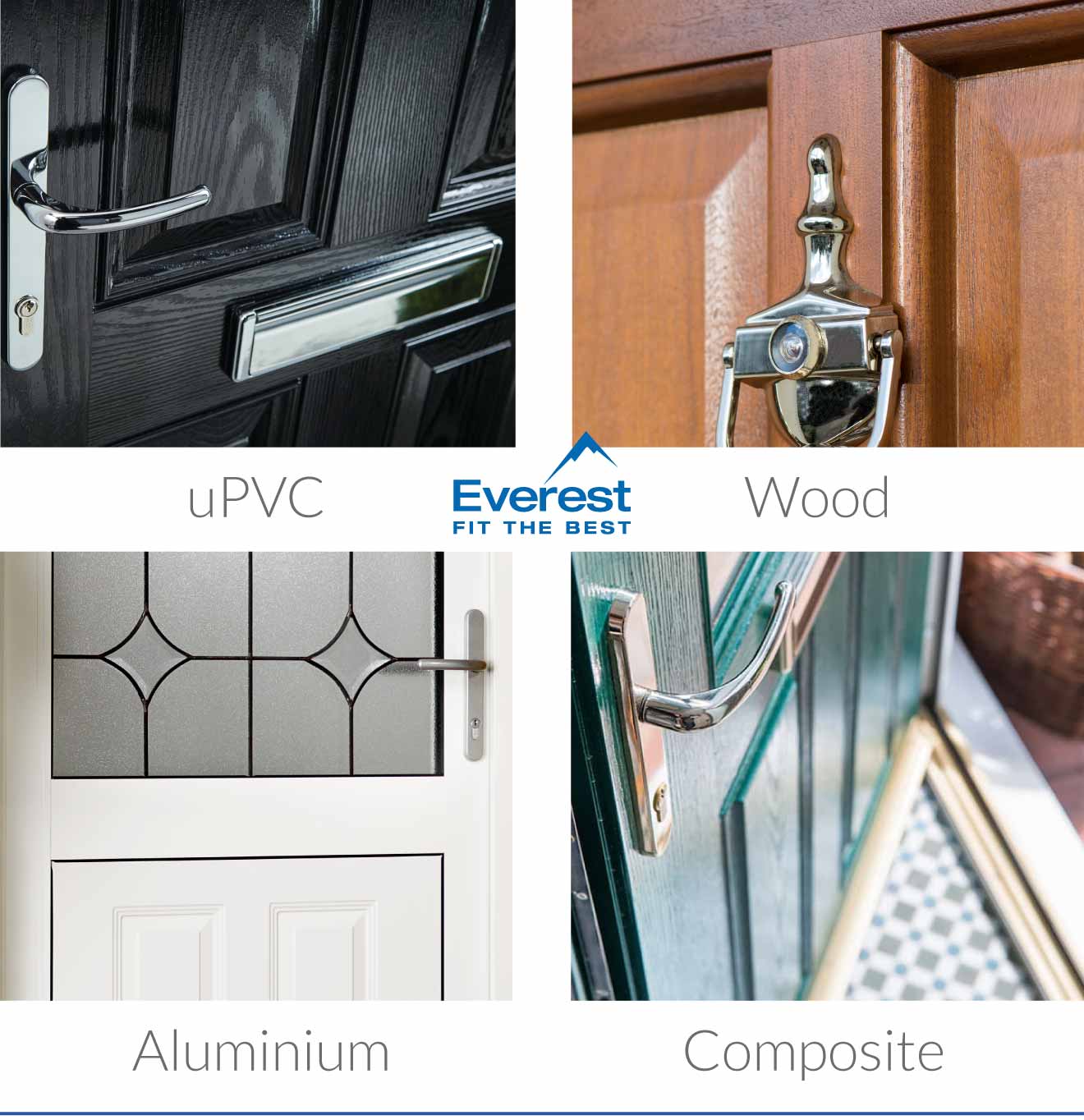Door materials
Advances in manufacturing technology now produce doors that are high-performance and offer better security, strength, energy efficiency and lifespan than before.
At Everest, our external door range is available in four types of material: timber, uPVC, aluminium and composite (GRP).


Wooden doors
Timber is a natural insulator – it absorbs and retains heat and solid wood doors offer the highest levels of energy efficiency compared to other door types.
Wooden doors have been around for centuries, but the manufacturing process has changed over time. Panels and frames are still made from solid wood, but timber used in construction is engineered to be stronger. Knots are removed from the wood, before layering different grain directions, and bonding. The result is a much stronger and more stable door, with no risk of warping or bowing.
Timber doors can be made from softwood or hardwood – both make great materials for doors. Hardwood grows slower than softwood so the rings are closer together, making it more dense and hardwearing. It does mean that it can be more expensive and less sustainable than softwood. Treated to resist rot and fungus, timber doors will last for years to come.
Timber doors are seen to be the most beautiful and can have a stained or painted finish with no limit to the number of times you change the colour. However, timber doors require more effort to keep them looking their best.
uPVC doors
uPVC is very popular in modern homes as it is a good all-round material that offers exceptional value. With a smooth and naturally weatherproof finish, they are virtually maintenance free. uPVC is also a naturally insulating material, and the frames and panels are designed to offer high levels of energy efficiency.
No longer 'flimsy' or 'brittle', modern uPVC doors are built to be sturdy and secure, with steel reinforced frames and panels. The hinges and locks are welded securely to the steel reinforcement within the frame, meaning that would-be intruders cannot gain entry through this previous weak spot.
Modern uPVC doors create a great first impression in a variety of colours including classic white and wood grain effect. With two colour doors, you can have a door that looks like timber from the outside, with white on the inside for a neutral colour palette.
Aluminium doors
The selling point of aluminium is how durable the material is and how little maintenance it needs. The material will not rust, peel or flake and is resistant to small knocks and scratches.
Once considered cold, aluminium doors have advanced their energy efficiency considerably and Everest uses a polyamide thermal insert to reduce thermal conductivity and reduce condensation. Glazed aluminium doors can have a slim profile that allows for a maximum area of glass and solid aluminium doors are incredibly strong and secure.
Aluminium doors are the most expensive choice for a front door, but they do have an expected lifetime of 45 years with little maintenance.
Aluminium is best suited to contemporary properties that want a sleek and stylish finish in combination with exceptional robust qualities.
Composite doors
Composite doors (also known as GRP) combine the benefits of different materials. Composites are made from a solid core: either a timber panel or a timber frame filled with high density foam. The inner frame and core is covered with a glass reinforced plastic (GRP) skin made using polyester resins and fibreglass. The same durable 'thermoplastic' outer coating is used on the underside of boats.
Composite doors are the only doors that can feature double rebates. A door rebate is where the door panel overlaps the frame along the edges, creating a barrier against water. Double rebates overlap twice, for increased energy efficiency and weather tightness. Dual rebated composite doors are often 50% thicker than regular front doors and feature triple glazing as standard.
Composite doors feature a moulded wood grain effect and the durable colour finish that is bonded with the surface offers a door that looks as good as timber but doesn’t need any maintenance.
Composite doors suit any type of property and are the most popular type of door we recommend.
Which material should I choose for my new door?
When you factor in all components, a composite door outperforms other door types and uPVC is the most popular choice for a door that looks good at a reasonable cost.
Timber is the best choice for period and heritage houses and If you live in a modern style house, aluminium framed doors will give your home a contemporary look.
The type of material you choose also depends on the style of door you're looking for. The period or age of your house is one of the most important considerations when choosing a new front door.
Read more: Different types of house style...